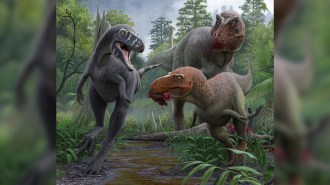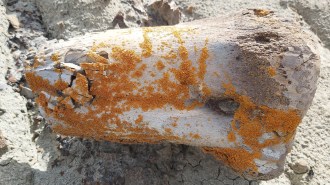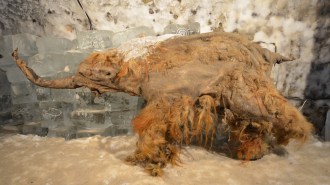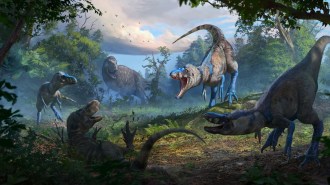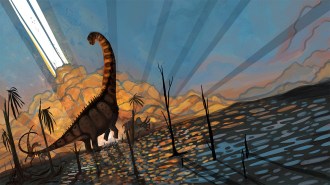New View: Fossil offers novel look at an ancient bird
A newly described specimen of an ancient creature that most scientists consider the oldest known bird is posed in a way that provides new viewing angles for several body features. Analyses of those traits bolster the notion that the 150-million-year-old creature, Archaeopteryx, as well as other birds, evolved from theropod dinosaurs, a team of scientists suggests.
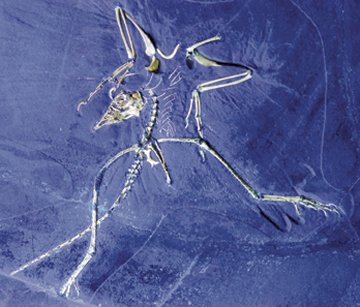
Many studies of previously described Archaeopteryx fossils, especially cranial scans that depict the creature’s braincase and inner ear (SN: 8/7/04, p. 86: Available to subscribers at Bird Brain? Cranial scan of fossil hints at flight capability), indicate that the creature could fly. The new fossil, only the 10th example of Archaeopteryx and its close relatives, is one of the best preserved, says Gerald Mayr, an ornithologist at the Senckenberg Research Institute in Frankfurt, Germany. It’s also the only specimen whose skull and body are seen not in profile but from above, he notes. This viewpoint reveals characteristics unseen or unpreserved in other fossils.
For instance, one palate component—a bone that’s broken, missing, or obscured in other Archaeopteryx specimens, says Mayr—has a shape that’s characteristic of the same bone in theropods. This long-lived group of bipedal, meat-eating dinosaurs in later ages included Tyrannosaurus rex.
The new specimen’s feet show resemblances to feet found in a subgroup of theropods called deinonychosaurs. For instance, each of the second toes had joints with a large range of motion and could be hyperextended, says Mayr. However, the deinonychosaur toes, but not those of Archaeopteryx, were probably useful for killing prey because they were large and had a large claw.
Furthermore, rather than pointing forward as in a theropod or backward as in a perching bird, the Archaeopteryx first toe pointed sideways as a human thumb does, says Mayr. That configuration is seen on both feet, so it probably isn’t simply related to the position in which the carcass was preserved. The thumblike position suggests that Archaeopteryx had limited perching capability and probably didn’t spend much time in trees, Mayr notes. He and his colleagues report their findings in the Dec. 2 Science.
This is a “very interesting” specimen because it reveals features of Archaeopteryx that are hard to see on the other nine fossils, says Larry D. Martin, a paleontologist at the University of Kansas in Lawrence. Most striking is the fossil’s apparently sprawling posture, he notes, a feature that Mayr and his colleagues didn’t remark upon in their report. Such a limb articulation, Martin adds, mirrors the one suggested for Microraptor gui. That 130-million-year-old creature from China had long feathers on its hind legs and may have splayed all four of its limbs to form an aerodynamic gliding surface (SN: 1/25/03, p. 51: Wings Aplenty: Dinosaur species had feathered hind limbs). Archaeopteryx had feathered hind limbs as well, Martin notes.
However, Martin disagrees with Mayr and his colleagues’ interpretation of how the living Archaeopteryx held its first toe. Rather than extending sideways, “it’s reversed [pointing backward] in this specimen, and it’s reversed in other specimens as well,” Martin contends.
Alan Feduccia, a paleobiologist at the University of North Carolina at Chapel Hill, also says that the new specimen’s first toe was reversed. That makes Mayr’s case against an arboreal lifestyle for Archaeopteryx unconvincing, Feduccia says. Moreover, all the known Archaeopteryx fossils, including the newly described one, have highly curved claws, a trait typical of modern perching birds but uncharacteristic of their ground-dwelling kin.


